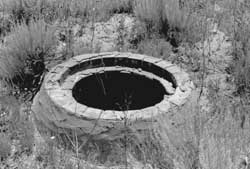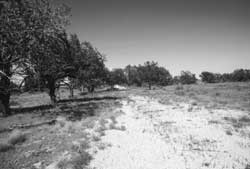MENU
|
| |
Confinement and Ethnicity: An Overview of World War II Japanese American Relocation Sites by J. Burton, M. Farrell, F. Lord, and R. Lord |

|
|
| |
Chapter 5 (continued)
Granada Relocation Center
Central (Fenced) Area
Today, the site of the Granada Relocation Center is remarkably intact, compared to many of the other relocation center sites. The central area is presently owned by the town of Granada, and one of the relocation center wells is used as the water source for the town. The only standing structures remaining from the relocation center use are a poured concrete room which was part of the co-op store, a small brick building at the cemetery, and the water reservoir and associated pump and well houses. However, traces of the whole central area of the relocation center are present — slab and footer foundations for most of the buildings remain, underground utilities appear to be intact (Figure 5.27), and roads still delineate the original blocks (Figure 5.28). Many of these roads, surfaced with a light tan gravel, are still driveable. Chinese elms and cottonwoods planted by the evacuees still survive and are the dominant vegetation, showing up in orderly rectangles on the USGS topographic map on the otherwise treeless prairie. Even most of the original security perimeter fence around the central area is still in place.
 Figure 5.27. Manhole in Block 10E at Granada. |
 Figure 5.28. Relocation center road at Granada today. |
There appear to have been only four major disturbances to the site since the buildings were removed in the 1940s: (1) a housing complex built where the hospital had been; (2) the present town landfill north of the relocation center landfill in the sewage treatment plant area; (3) a cylindrical metal water tank in Block 11K, added in the late 1960s; and (4) a recent well in Block 11F.
 Top
Top
Last Modified: Fri, Sep 1 2000 07:08:48 pm PDT
http://www.cr.nps.gov/history/online_books/anthropology74/ce5d.htm
![]()

